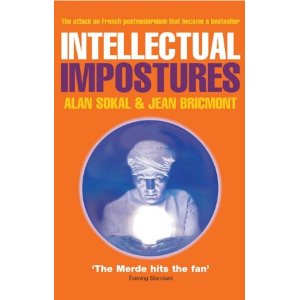 You’re probably familiar with the original Sokal’s Hoax. If not here’s a brief summary otherwise skip down to the Sokal 2 heading.
You’re probably familiar with the original Sokal’s Hoax. If not here’s a brief summary otherwise skip down to the Sokal 2 heading.
The Sokal hoax was perpetrated by Alan Sokal, a professor of physics+mathematics dismayed at the excesses of postmodernism in academia. He was particularly annoyed by the radical social constructivist project that stated that all knowledge (especially science, being the object in question) is socially constructed and is simply the result of social negotiation between the power parties. Particularly egregious in his view was that academics in this arm of science studies were happy to write on areas of science they knew very little about. As long as a paper was couched in obscure terminology and complex yet vague language it created the illusion that it was profound.
Sokal wrote a joke paper that he knew to be (1) completely meaningless (2) completely missing the point of the scientific theories it was meant to be discussing and (3) supporting the all-knowledge-is-relative viewpoint. He submitted it to the academic journal Social Text. It was accepted and when revealed a hoax the academic world exploded with debate about postmodernism (as well as academic integrity and so on).
The paper is called Transgressing the Boundaries: Towards a Transformative Hermeneutics of Quantum Gravity. The paper is The Original Poe, and I’ll only quote from a footnote quoted in the Wikipedia article that shows how hilarious the whole thing is:
Just as liberal feminists are frequently content with a minimal agenda of legal and social equality for women and ‘pro-choice’, so liberal (and even some socialist) mathematicians are often content to work within the hegemonic Zermelo-Fraenkel framework (which, reflecting its nineteenth-century liberal origins, already incorporates the axiom of equality) supplemented only by the axiom of choice.
If you don’t know a little bit about the math in the paragraph you’re missing out on just how ridiculous this is. In which case, simply compare the informal definition of the axiom of choice from here to the concept of being pro-choice.
Sokal 2
 Although it happened just a year after the Sokal hoax (ie. 1997), I think this one is just as amusing. This one was initiated by neuroscientist V(ilayanur) S(ubramanian) Ramachandran. He’s known as Rama for short even in academia so I’ll refer to him as Rama. He’s got some fascinating researhc and books out which I’ll cover at a later stage, for an intro see his TED talk.
Although it happened just a year after the Sokal hoax (ie. 1997), I think this one is just as amusing. This one was initiated by neuroscientist V(ilayanur) S(ubramanian) Ramachandran. He’s known as Rama for short even in academia so I’ll refer to him as Rama. He’s got some fascinating researhc and books out which I’ll cover at a later stage, for an intro see his TED talk.
Rama was critical of the excesses of evolutionary psychology. The entire field is still controversial, the strongest criticism being the idea that it’s simply a pseudoscience aimed at reinforcing the status quo. A milder one more common to academic critics is that its evidential base is very shaky consisting largely of evolutionary just-so stories that simply sound good when doing armchair speculation. There’s a full discussion to be had on these but not in this post — the only relevant bit is Rama does hold that latter opinion.
He concocted a just-so story as a joke entitled Why do gentlemen prefer blondes? It was written in the style of an evo-psych paper complete with citations. He also submitted it to a journal and got it published. Now, I don’t know if many postmodernists are claiming that Sokal’s paper is still valid (ie. makes a solid argument despite being written as a hoax). According to Rama though, there are evolutionary psychologists who find the paper convincing. Which doesn’t automatically mean it isn’t but is still funny.
It’s short so my abridgement below should give a good gist. Full paper PDF link here.
It is well known ““ although rarely acknowledged in polite company ““ that in Western cultures there exists a distinct esthetic/sexual preference among men for blondes over brunettes (Anstis S M, personal communication) (1,2).
[…]
Here, I propose a third view that…has the added advantage of being consistent with more general biological theories of mate selection. Several authors have suggested that certain florid displays of secondary sexual characteristics ““ such as the peacock’s tail or the rooster’s bright-red wattles ““ may serve the purpose of “˜informing’ the female that the suitor is healthy and free of dermal parasites (6, 7). I suggest that being blonde, or light-skinned, serves a similar purpose. Every medical student knows that anemia (usually caused by intestinal parasites), cyanosis (a sign of heart disease), jaundice (liver disease) and skin infection are much easier to detect in fair-skinned individuals than in brunettes.
[…]
A second, related reason…might be that the absence of protection
from ultraviolet radiation by melanin causes the skin of blondes to “˜age’ faster than brunettes and the dermal signs of aging (e.g. dark “˜age spots’ and wrinkles) are usually easier to detect. Since fertility in women declines rapidly with age, it has been suggested (2, 9) that aging men prefer very young women as sexual partners (Anstis, S M, personal communication).
[…]
Third, it also seems likely that certain external signs of sexual interest ““ such as social embarrassment and blushing ““ as well as sexual arousal (e.g. the “˜flush’ of orgasm) would be difficult to detect in dark-skinned women; so that the likelihood that one’s courtship gesture will be reciprocated and consummated can be predicted with greater confidence when courting blondes.




0 Comments